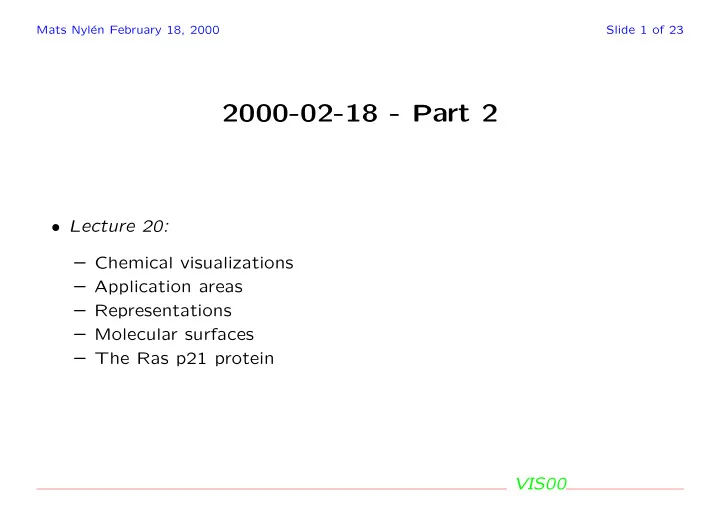

Mats Nyl´ en February 18, 2000 Slide 1 of 23 2000-02-18 - Part 2 • Lecture 20: – Chemical visualizations – Application areas – Representations – Molecular surfaces – The Ras p21 protein VIS00
Mats Nyl´ en February 18, 2000 Slide 2 of 23 Chemical visualization Lots of software packages exists for chemical visualisation, some examples are rasmol, O, Ribbons, MOLMOL, gOpenMol and ICM . Molecules and other atomic structures can be visualized in a lot of different ways, depending in which information is sought. Various structural representations and colouring schemes may be used. VIS00
Mats Nyl´ en February 18, 2000 Slide 3 of 23 Application areas This a short, incomplete list of application areas • molecular viewing in Chemistry, • Biochemistry, • Structural Biology, • Bioinformatics and microbiology, • Solid state Physics (and Chemistry) And many, many others. VIS00
Mats Nyl´ en February 18, 2000 Slide 4 of 23 Structural represenations Some structural represenations: • atomic positions (primary structure), • secondary structure (chains, ribbons etc.), • tertiary structure, • various surface representations (isovalue elctronic density, Van der Waals surface, Connolly surface etc.) VIS00
Mats Nyl´ en February 18, 2000 Slide 5 of 23 Colouring schemes Some useful colouring schemes • by atom type (e.g. CPK ), • by structural part, • by property (e.g., map the electrostatic potential as colour on the Con- nolly surface). VIS00
Mats Nyl´ en February 18, 2000 Slide 6 of 23 Primary Structure Representations of the primary structure makes sense for smaller molecules, crystals and for details. Common representations are • Space filling spheres, • Stick models, • Ball and Stick models, • Ball and structure models. And, of course, others. In a primary structure representation all atoms are represented (almost). VIS00
Mats Nyl´ en February 18, 2000 Slide 7 of 23 Space filling example VIS00
Mats Nyl´ en February 18, 2000 Slide 8 of 23 Ball and Stick VIS00
Mats Nyl´ en February 18, 2000 Slide 9 of 23 Solid state physics VIS00
Mats Nyl´ en February 18, 2000 Slide 10 of 23 Tl 2 Ba 2 Ca 0 Cu 1 O 6+ δ VIS00
Mats Nyl´ en February 18, 2000 Slide 11 of 23 Secondary structure VIS00
Mats Nyl´ en February 18, 2000 Slide 12 of 23 Secondary structure: Backbone VIS00
Mats Nyl´ en February 18, 2000 Slide 13 of 23 Secondary structure: Ribbons VIS00
Mats Nyl´ en February 18, 2000 Slide 14 of 23 Molecular surfaces VIS00
Mats Nyl´ en February 18, 2000 Slide 15 of 23 Isovalue surfaces Examples include • Electron density, • Molecular orbitals (remember hydrogen.fld ) • Electrostatic potential • Spin Density VIS00
Mats Nyl´ en February 18, 2000 Slide 16 of 23 Molecular orbitals Here is a couple of examples showing orbital isovalues: VIS00
Mats Nyl´ en February 18, 2000 Slide 17 of 23 Properties on surfaces Various properties can be mapped onto various surfaces Properties Surfaces Electron density Connolly surface Molecular orbitals Electron density isosurface Electrostatic potential Spin density isosurface Spin density Electrostatic potential isosurface Various energies VIS00
Mats Nyl´ en February 18, 2000 Slide 18 of 23 Electrostatic potential Mapped onto the Connolly surface. VIS00
Mats Nyl´ en February 18, 2000 Slide 19 of 23 Combinations This shows a semitransparent Connolly surface with a Stick model of the molecule VIS00
Mats Nyl´ en February 18, 2000 Slide 20 of 23 Resources and references A lot of resources are available on the Web. Here are some that I have used • The Protein Databank: http://www.rcsb.org/pdb • MOLMOL homepage: http://www.mol.biol.ethz.ch/wuthrich/software/molmol • gOpenMol homepage: http://www.csc.fi/~ laaksone/gopenmol/gopenmol.html • Rasmol homepage: http://www.umass.edu/microbio/rasmol • Overview of representations: http://scsg9.unige.ch/fln/eng/toc.html • Linux Chemistry resources: http://chpc06.ch.unito.it/chem linux.html VIS00
Mats Nyl´ en February 18, 2000 Slide 21 of 23 The Ras p21 protein The Ras p21 protein is a central component in the cell-signalling system that transmits extra-cellular growth signals via cell membrane receptors, via a cascade of signalling molecules into the nucleus. It is present in many cell types, and several forms of cancer are associated with a mutated form of the protein, where it is locked in a growth-promoting state. Ras p21 is an enzyme; it hydrolyzes GTP (guanosine triphosphate) to GDP (guanosine diphosphate); it is a GTPase. The protein exists in vivo as a ternary complex with one magnesium ion (Mg) and GDP (or GTP). VIS00
Mats Nyl´ en February 18, 2000 Slide 22 of 23 Ras p21 on Display VIS00
Mats Nyl´ en February 18, 2000 Slide 23 of 23 Summary and Outlook This has been a very brief overview of some topics in chemical visualization. Espicially in microbiology there is a relation between structure and function of the molecules. So we try to encode function into the visualizations. VIS00
Recommend
More recommend